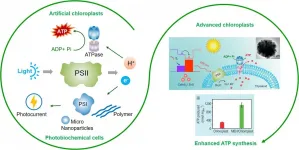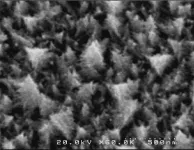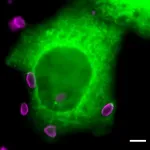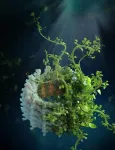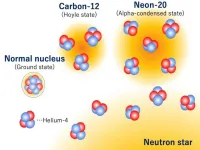Light-sensitive protein in eye of birds is magnetic sensitive as well
2021-06-24
(Press-News.org) Recently, a collaboration of researchers from the Hefei Institutes of Physical Science (HFIPS), Universities of Oldenburg (Germany) and Oxford (UK) have been gathering evidence suggesting that a specific light-sensitive protein in the eye named cryptochrome 4 is sensitive to magnetic fields and plays essential roles in magnetic sensing in migratory birds such as European robins. The results have been published in Nature (https://doi.org/10.1038/s41586-021-03618-9) on June 23 and selected as the cover paper.
For the first time, first author XU Jingjing, a doctoral student in Mouritsen's research group at Oldenburg, with the help of XIE's group, produced cryptochrome 4 in night-migratory European robins in large quantities using bacterial cell cultures. "The expression of bird cryptochromes with the FAD incorporated was a major achievement and served as a crucial first step in this project," said Mouritsen.
The Oxford labs of Christiane Timmel and Stuart Mackenzie used a wide range of magnetic resonance and novel optical spectroscopy techniques to study the protein and demonstrate its pronounced sensitivity to magnetic fields.
The international team deciphered the mechanism by which this sensitivity arises. "Electrons that can move within the molecule after blue-light activation play a crucial role," said Mouritsen. Proteins like cryptochrome consist of chains of amino acids: robin cryptochrome 4 has 527 of them. Four of the 527 - known as tryptophans - are essential for the magnetic properties of the molecule. The idea was supported by Hore and Ilia Solov'yov (Oldenburg), who performed quantum mechanical calculations in this project.
According to their calculations, electrons hop from one tryptophan to the next generating so-called radical pairs which are magnetically sensitive. To prove this experimentally, the team from Oldenburg produced slightly modified versions of the robin cryptochrome, in which each of the tryptophans in turn was replaced by a different amino acid to block the movement of electrons. Using these modified proteins, the Oxford team demonstrated experimentally that electrons move within the cryptochrome as predicted in the calculations - and that the generated radical pairs are essential to explain the observed magnetic field effects.
Hore said, "if we can prove that cryptochrome 4 is the magnetic sensor we will have demonstrated a fundamentally quantum mechanism that makes animals sensitive to environmental stimuli a million times weaker than previously thought possible". But, the researchers admited this is not definitive proof that cryptochrome 4 was the magnetic sensor they were looking for.
In all experiments, they examined isolated proteins in the laboratory. The magnetic fields used were also stronger than the Earth's magnetic field. "We think these results are very important because they show for the first time that a molecule from the visual apparatus of a migratory bird is sensitive to magnetic fields." said Mouritsen. "But it still needs to be shown that this is happening in the eyes of birds." Unfortunately, such studies are not yet technically possible.
They believed the proteins involved could be significantly more sensitive in their native environment. In cells in the retina, the proteins are probably fixed and aligned, increasing their sensitivity to the direction of the magnetic field. Moreover, they were also likely to be associated with other proteins that could amplify the sensory signals.
"We are still looking for other proteins that may participate in this complicated machinery, including but certainly not limited to MagR. We are open-minded and would not exclude any possible partners at this stage", said XIE.
MagR is an iron-sulfur cluster protein discovered by XIE's group five years ago as a putative magnetoreceptor, though the exact mechanism is still to be answered. It is suggested to interact with cryptochrome 4 to form a nanoscale 'needle' in vitro: a rod-like core of MagR polymer with an outer layer of cryptochromes (DOI: 10.1038/nmat4484).
INFORMATION:
The work was funded by the National Natural Science Foundation of China and the Presidential Foundation of Hefei Institutes of Physical Science, Chinese Academy of Sciences to XIE's group, and a 6-year Synergy Grant from the European Research Council with the title 'QuantumBirds' to the Oldenburg and Oxford teams.
[Attachments] See images for this press release:
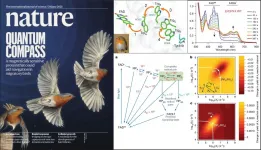
ELSE PRESS RELEASES FROM THIS DATE:
2021-06-24
BIRMINGHAM, Ala. - A bout with flu virus can be hard, but when Streptococcus pneumonia enters the mix, it can turn deadly.
Now researchers have found a further reason for the severity of this dual infection by identifying a new virulence mechanism for a surface protein on the pneumonia-causing bacteria S. pneumoniae. This insight comes more than three decades after discovery of that surface protein, called pneumococcal surface protein A, or PspA.
This new mechanism had been missed in the past because it facilitates bacterial adherence only to dead or dying lung epithelial cells, not to living cells. Heretofore, researchers typically used healthy lung ...
2021-06-24
Ultrasound can overcome some of the detrimental effects of ageing and dementia without the need to cross the blood-brain barrier, Queensland Brain Institute researchers have found.
Professor Jürgen Götz led a multidisciplinary team at QBI's Clem Jones Centre for Ageing Dementia Research who showed low-intensity ultrasound effectively restored cognition without opening the barrier in mice models.
The findings provide a potential new avenue for the non-invasive technology and will help clinicians tailor medical treatments that consider an individual's disease progression and cognitive decline.
"Historically, ...
2021-06-24
Are the traditional practices tied to endangered species at risk of being lost? The answer is yes, according to the authors of an ethnographic study published in the University of Guam peer-reviewed journal Pacific Asia Inquiry. But the authors also say a recovery plan can protect both the species as well as the traditional CHamoru practice of consuming them.
Else Demeulenaere, lead author of the study and associate director of the UOG Center for Island Sustainability, presented on their findings during the Marianas Terrestrial Conservation Conference on June 8.
Strong ...
2021-06-24
In the recent decade, scientists have paid more attention to studying light harvest for producing novel bionic materials or integrating naturally biological components into synthetic systems. Inspiration is the imitation of natural photosynthesis in green plants, algae, and cyanobacteria to convert light energy into chemical energy. Photosystem II (PSII) is a light-intervened protein complex responsible for the light harvest and water splitting to release O2, protons, and electrons. The development of PSII-based biomimetic assembly in vitro is favorable for the investigation of photocatalysis, biological solar cells, and bionic photosynthesis, further help us reveal more secret of photosynthesis.
The combination of PSII and artificially synthetic structures is successful for ...
2021-06-24
Ishikawa, Japan - Nanostructured metal surface has novel physical and chemical properties, which have sparked scientific interest for heterogeneous catalysis, biosensors, and electrocatalysis. The fabrication process can influence the shapes and sizes of metal nanostructures. Among various fabrication processes, the electrochemical deposition technique is widely used for clean metal nanostructures. Applying the technique, a team of researchers led by Dr. Yuki Nagao, Associate Professor at Japan Advanced Institute of Science and Technology (JAIST) and Md. Mahmudul Hasan, a PhD student at JAIST, succeeded to construct Pd-based catalysts having unique morphology.
In this study, the team has successfully synthesized Christmas-tree-shaped palladium nanostructures on the GCE ...
2021-06-24
Toxoplasma gondii, the parasite responsible for toxoplasmosis, is capable of infecting almost all cell types. It is estimated that up to 30% of the world's population is chronically infected, the vast majority asymptomatically. However, infection during pregnancy can result in severe developmental pathology in the unborn child. Like the other members of the large phylum of Apicomplexa, Toxoplasma gondii is an obligate intracellular parasite which, to survive, must absolutely penetrate its host's cells and hijack their functions to its own advantage. Understanding how the parasite manages to enter host cells offers new opportunities to develop more effective prevention and control strategies than those currently available. A team from the University of Geneva (UNIGE), in collaboration ...
2021-06-24
An international study led by Helmholtz Zentrum München has revealed the structure of a membrane-remodeling protein that builds and maintains photosynthetic membranes. These fundamental insights lay the groundwork for bioengineering efforts to strengthen plants against environmental stress, helping to sustaining human food supply and fight against climate change.
Plants, algae, and cyanobacteria perform photosynthesis, using the energy of sunlight to produce the oxygen and biochemical energy that power most life on Earth. They also adsorb carbon dioxide (CO?) from the atmosphere, counteracting the accumulation of this greenhouse gas. However, climate change ...
2021-06-24
Men - more often than women - need passion to succeed at things. At the same time, boys are diagnosed as being on the autism spectrum four times as often as girls.
Both statistics may be related to dopamine, one of our body's neurotransmitters.
"This is interesting. Research shows a more active dopamine system in most men" than in women, says Hermundur Sigmundsson, a professor at the Norwegian University of Science and Technology's (NTNU)Department of Psychology.
He is behind a new study that addresses gender differences in key motivating factors for what it takes to become good at something. The study uses men's and women's differing activity in the dopamine system as an explanatory model.
"We looked at gender differences around passion, self-discipline ...
2021-06-24
Researchers from Skoltech and their colleagues have shown that adaptation to similar environments hardly involves similar genomic positions when species are distantly related. The team investigated recurrent adaptations of wildlife birds' mitochondria to high altitude, migration, diving, wintering, and flight. Repeatable substitutions are rather a coincidence than adaptation, which confirms the scientific opinion that distant species "choose" different ways of similar trait evolution. The paper was published in the journal Genome Biology and Evolution.
If an organism wants to survive in unusual conditions, such as oxygen starvation typical for high altitudes or elevation of metabolism rate due to extreme temperatures, it has to adapt. If different species meet similar environment ...
2021-06-24
Osaka, Japan - Scientists from the Department of Physics and the Research Center for Nuclear Physics (RCNP) at Osaka University, in collaboration with Kyoto University, used alpha particle inelastic scattering to show that the theorized "5α condensed state" does exist in neon-20. This work may help us obtain a better understanding the low-density nucleon many-body systems.
All elements besides hydrogen and helium must have been fused inside the nuclear furnace of a star. The yield during these reactions of carbon-12, which has six protons and six neutrons, is increased by an ...
LAST 30 PRESS RELEASES:
[Press-News.org] Light-sensitive protein in eye of birds is magnetic sensitive as well




